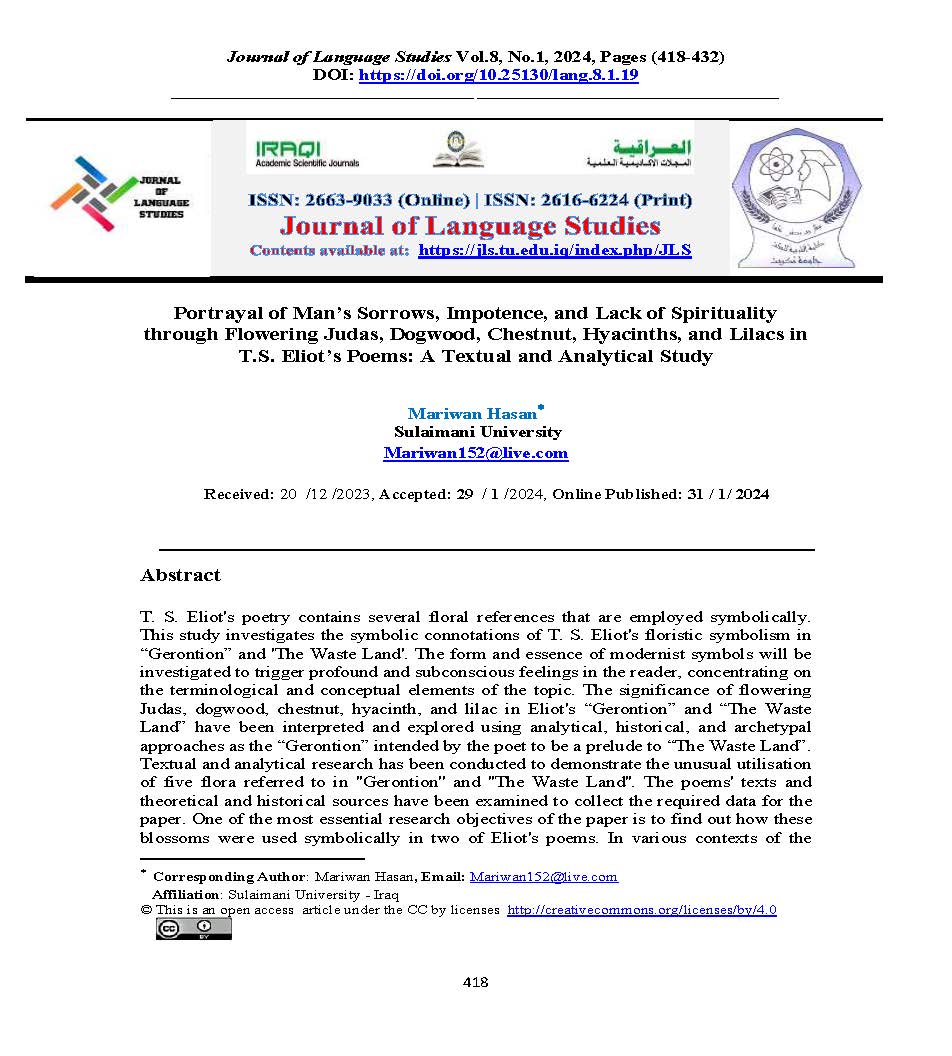Portrayal of Man’s Sorrows, Impotence, and Lack of Spirituality through Flowering Judas, Dogwood, Chestnut, Hyacinths, and Lilacs in T.S. Eliot’s Poems: A Textual and Analytical Study
DOI:
https://doi.org/10.25130/lang.8.1.19Keywords:
T.S. Eliot, “Gerontion”, “The Waste Land”, rebirth, floristic imagery in poetry, „flowering Judas, chestnut, dogwood, hyacinths, lilacsAbstract
- S. Eliot's poetry contains several floral references that are employed symbolically. This study investigates the symbolic connotations of T. S. Eliot's floristic symbolism in “Gerontion” and 'The Waste Land'. The form and essence of modernist symbols will be investigated to trigger profound and subconscious feelings in the reader, concentrating on the terminological and conceptual elements of the topic. The significance of flowering Judas, dogwood, chestnut, hyacinth, and lilac in Eliot's “Gerontion” and “The Waste Land” have been interpreted and explored using analytical, historical, and archetypal approaches as the “Gerontion” intended by the poet to be a prelude to “The Waste Land”. Textual and analytical research has been conducted to demonstrate the unusual utilisation of five flora referred to in ''Gerontion'' and ''The Waste Land''. The poems' texts and theoretical and historical sources have been examined to collect the required data for the paper. One of the most essential research objectives of the paper is to find out how these blossoms were used symbolically in two of Eliot's poems. In various contexts of the poem (historical, biographical, mythological, cultural, anthropological, etc.), the symbolic and common meanings of each flower has been investigated.
References
Blistein, B. The design of “The Waste Land” / B. Blistein. – Lanham, Maryland: University Press of America, 2008.
Bloom, H. T.S. Eliot’s “The Waste Land” / H. Bloom. – Infobase Publishing, 2007.
Brooker, J. S. Reading “The Waste Land”. Modernism and the Limits of Interpretation J. S. Brooker, J. Bentley. Amherst: The University of Massachusetts Press, 1990.
Coleman, R. T.S. Eliot’s rose symbol: its significations in mythology, folk-lore, historic incident, and religion / R. Coleman. – University of Ottawa, 1960.
Dafoe, N. Breaking open the box: a guide for creative techniques to improve academic writing and generate critical thinking / N. Dafoe. – R&L Education, 2013.
Dickey, F. Reports from Emily Hale archive / F. Dickey. – URL: T.S. Eliot Society.wildapricot.org/news (mode of access: 20.08.2020). – Text: electronic.
Eliot, T. S. The poems of T.S. Eliot. Vol. 1. Collected and Uncollected Poems, T. S. Eliot; ed. by Ch. Ricks, J. McCue. – London: Faber and Faber, 2015.
--- "Gerontion," in The Complete Poems and Plays, 1909-1950. New York: Harcourt, Brace & World, Inc., 1971.
Frye, N. T.S. Eliot N. Frye. – Edinburg; London: Oliver and Boyd, 1963.
Gardening Tips. Pruning Lilacs. – URL: www.swansonsnursery.com/blog/pruning-lilacs (mode of access: 20.08.2020).
Forstner, Dorothea. Åšwiat symboliki chrzesÌcijaÅ„skiej, trans. Zakrzewska, Wanda, PaweÅ‚ Pachciarek, and Ryszard TurzyÅ„ski. Warszawa: Instytut Wydawniczy PAX, 1990.
Griffith, Clark. "Eliot’s' Gerontion." Explicator 21.6 (1963).
– Text: electronic. Hyacinths. – Text: electronic // T.S. Eliot Waste Land Wiki. – URL: https:tseliotsthewasteland.fandom.com/wiki/ Hyacinths (mode of access: 20.08.2020). 180
Miller, J. E. T. S. Eliot’s personal Waste Land: exorcism of the demons / J. E. Miller. – Penn State Press, 2010.
Min, Hyun Young. "“Gerontion”: I Have Lost My Passion." 영어영문학연구 24 (1983): 131-143.
Monteiro, G. T.S. Eliot’s personal complaint in “The Waste Land” / G. Monteiro // Yeats Eliot Review. – 2015. – № 31.1/2: 33.
Ovidi, Nasonis. Metamorphoseon liber decimvs. – URL: www.thelatinlibrary.com/ovid/ovid.met10.shtml (mode of access: 20.08.2020). – Text: electronic.
Ransom, John Crowe. “Gerontion.” The Sewanee Review, vol. 74, no. 2, 1966, pp. 389–414. JSTOR, http://www.jstor.org/stable/27541411. Accessed 7 Oct. 2023.
Ricks, Ch. Commentary / Ch. Ricks // The poems of T.S. Eliot. Vol. 1. Collected and Uncollected Poems / ed. by Ch. Ricks, J. McCue. – London: Faber and Faber, 2015. – P. 349–1228.
Slote, B. Foreword / B. Slote // Myth and symbol. Critical approaches and applications / by N. Frye, L. C. Knights, et al.; ed. by B. Slote. – Lincoln: University of Nebraska Press, 1963.
Smith, G. T. S. Eliot’s poetry and plays. A study in sources and meaning / G. Smith. – Chicago; London: The University of Chicago Press, 1967.
Southam, B. C. A guide to “The Selected Poems” of T.S. Eliot / B. C. Southam. – Sixth Edition. – San Diego ; New York ; London : A Harvest Original ; Harcourt Brace & Company, 1996.
Thormahlen, M. The Waste Land. A fragmentary wholeness / M. Thormahlen. – Lund: CWK Gleerup, 1978.
Tiwari, Nidhi. Imagery and Symbolism in T.S Eliot's Poetry. Atlantic Publishers & Dist, 2001.
Ushakova, O. M. Invitation to the dance: intermedial allusions in T. S. Eliot’s early poetry (‘The Death of Saint Narcissus’, ‘Suppressed Complex’) / O. M. Ushakova // Philological Class. – 2019. – № 1 (55). – P. 136–143.
Wilde, Julia Helena. " ‘Dogwood and Chestnut, Flowering Judas’: The Role of Tree Images in T.S. Eliot’s Poetry." New Horizons in English Studies 4.1 (2019): 52-66.
The Legend of the Dogwood | Bower & Branch (www.bowerandbranch.com) Accessed on 06/10/2023.

